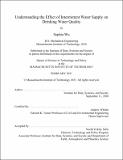| dc.contributor.advisor | Andrew Whittle. | en_US |
| dc.contributor.author | Wu, Sophia(Sophia W.) | en_US |
| dc.contributor.other | Massachusetts Institute of Technology. Institute for Data, Systems, and Society. | en_US |
| dc.contributor.other | Technology and Policy Program. | en_US |
| dc.date.accessioned | 2021-06-17T17:21:05Z | |
| dc.date.available | 2021-06-17T17:21:05Z | |
| dc.date.copyright | 2021 | en_US |
| dc.date.issued | 2021 | en_US |
| dc.identifier.uri | https://hdl.handle.net/1721.1/131001 | |
| dc.description | Thesis: S.M. in Technology and Policy, Massachusetts Institute of Technology, School of Engineering, Institute for Data, Systems, and Society, Technology and Policy Program, February, 2021 | en_US |
| dc.description | Cataloged from the official PDF of thesis. | en_US |
| dc.description | Includes bibliographical references (pages 78-82). | en_US |
| dc.description.abstract | There are nearly 1 billion people who obtain their drinking water through piped distribution networks that operate intermittently. Intermittent Water Supply (IWS) operations allow for periods of stagnation and depressurization that create conditions favorable for biofilm growth on pipe surface. Biofilms are complex microbial communities that are likely sources of opportunistic waterborne pathogens and can cause disease outbreaks. Flushing of the water pipes and re-pressurization, which occur at the start of each IWS supply cycle, cause the erosion of the biofilm and its transport into the bulk water, which can potentially contaminate the drinking water. This thesis describes the development and proof-testing of an experimental pipe testbed installed on the Nanyang Technological University (NTU) campus in Singapore. | en_US |
| dc.description.abstract | The testbed comprises an array of 100 mm diameter PVC pipes, supplied from a water tank with flow paths controlled through a set of valves, and water samples obtained at up to 7 pipe outlets. Data are presented from an initial program of tests that compare the effects of priming for two pipe sections: 1) with continuous laminar flow (Continuous Water Supply, CWS) under pressure; and 2) IWS, where the pipe section is flushed during re-pressurization (supply period) and then allowed to drain and stagnate for the remainder of the daily cycle. The change of the water quality from both the inlet and outlet was evaluated by determining the microbial load using flow cytometry (with Live/Dead staining), together with physical and chemical water parameters measured on a time series of water samples. | en_US |
| dc.description.abstract | The data compare the response of the CWS pipe section for steady laminar flow, with the transient response following a step-change in flow rate (turbulent conditions) with transient behavior during flushing of the IWS section. Initial filling of the IWS section cause a significant increase in total and live cell counts, confirming that erosion of biofilm can contribute to biomass transported in the bulk water. Further tests are in progress to validate and replicate these results. | en_US |
| dc.description.statementofresponsibility | by Sophia Wu. | en_US |
| dc.format.extent | 82 pages | en_US |
| dc.language.iso | eng | en_US |
| dc.publisher | Massachusetts Institute of Technology | en_US |
| dc.rights | MIT theses may be protected by copyright. Please reuse MIT thesis content according to the MIT Libraries Permissions Policy, which is available through the URL provided. | en_US |
| dc.rights.uri | http://dspace.mit.edu/handle/1721.1/7582 | en_US |
| dc.subject | Institute for Data, Systems, and Society. | en_US |
| dc.subject | Technology and Policy Program. | en_US |
| dc.title | Understanding the effect of intermittent water supply on drinking water quality | en_US |
| dc.type | Thesis | en_US |
| dc.description.degree | S.M. in Technology and Policy | en_US |
| dc.contributor.department | Massachusetts Institute of Technology. Institute for Data, Systems, and Society | en_US |
| dc.contributor.department | Technology and Policy Program | en_US |
| dc.contributor.department | Massachusetts Institute of Technology. Engineering Systems Division | |
| dc.identifier.oclc | 1256585643 | en_US |
| dc.description.collection | S.M.inTechnologyandPolicy Massachusetts Institute of Technology, School of Engineering, Institute for Data, Systems, and Society, Technology and Policy Program | en_US |
| dspace.imported | 2021-06-17T17:21:05Z | en_US |
| mit.thesis.degree | Master | en_US |
| mit.thesis.department | TPP | en_US |
| mit.thesis.department | ESD | en_US |
| mit.thesis.department | IDSS | en_US |
